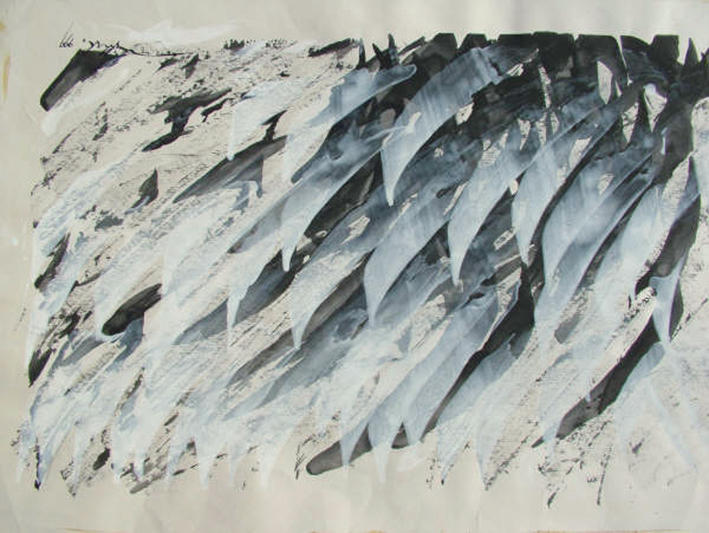
Freiburg
Iran.com — Iranian Art Today
Museum für Neue Kunst Freiburg im Breisgau
October 22, 2006–January 28, 2007
iran.com — Iranian Art Today — as both a title and an event — hopes to achieve an awful lot. According to one of the catalogue essays, the dot-com rubric exists as a double metaphor: Iranians, Iranian youth in particular, are renowned for their use of the internet as a space for expression (blog culture today is de rigeur). Simultaneously, curators Isabel Herda and Nicoletta Torcelli hoped to create a space for a fresh view of a nation often encumbered by essentialist stereotypes.
Such ambitious desires are manifest in work by Afshan Ketabchi, who presents a series of large-format digital prints on canvas that reinterpret the style of Persian miniatures by presenting sexually explicit scenes. Collectively titled Harem (2005), the series portrays women lounging, à la Ingres, wearing Playboy bunny ears and bondage gear. All the same, the double goals of countering stereotypes and creating a space for open expression can conflict at times; while purportedly liberating the Oriental woman from “the image of the woman as powerless victim,” these images nonetheless perpetuate the mythology of exotic eroticism… and so we come full circle.
Other work, such as Majid Koorang Beheshti’s otherworldly black and white photographs from The Cubic Path series (2006) and Minoo Iranpour’s video The Door (2004), both shot in and around Isfahan, are insistent about showing the precise opposite of a romanticized Oriental paradise — no mysterious golden mosques, and instead, stark, barren landscapes.
The use of video in the show is ubiquitous. Simin Keramati’s Silence (2004), in which a huge, projected male hand working prayer beads makes an endlessly rhythmic clacking, functions as an oversized metaphor for the relentless weight of religious power. Barbad Golshiri’s Alephallus and the History of Image (2004), which shows a young woman repeatedly trying to enunciate the letter Aleph (the first letter of the Hebrew, Persian, and Arabic alphabets), is a performance situated somewhere between a prayer and a song. Its message? We all spring from the same roots. A documentary of Shahab Fotoui and Neda Razavipour’s 2003 Tehran installation Census, in which they filled the windows of an unfinished skyscraper with 70 closeup photographs of people from the area, is both poetic and haunting. Lit from behind, the skyscraper flickered at night like a flame. Custom-prepared for this exhibition, a selection of the faces are displayed on illuminated advertising billboards throughout Freiburg: inconspicuous yet omnipresent, they appear as a subtle, intensely relevant comment on immigration in this new European context.
Khosrow Hassanzadeh, for his part, shows Terrorist (2004) — monumental silkscreen and acrylic portraits of himself and his family that seem to allude to the culture of racial profiling. Rokneddin Haerizadeh participates in the show with his accomplished, brightly colored contemporary reinterpretations, also of Persian miniature paintings, while Ahmad Morshedloo’s creepy large-scale figurative works evoke a personal world that is crowded but somehow isolating. These works are compelling enough but, particularly in the case of the last two, feel misplaced. Mahmoud Bakhshi-Moakhar presents a three-part installation, Anonymous Martyr, consisting of Air Pollution — eight Iranian flags, one for each year of the Iran-Iraq war, disfigured by air pollution and hung on the walls; the video Military Service, visible only through a peephole, which reveals a man’s mouth eating a watermelon (green, white, and red being the colors of the national flag); and Holy Tombs — three fluorescent mini-cameras, tourist trinkets that usually have cityscapes in the viewfinder but here show the fresh graves of so-called martyrs, their bodies wrapped in the flag.
The artistic duo Farhad Moshiri and Shirin Aliabadi, meanwhile, contribute a selection from the ongoing (since 2003) series Battlegrounds of the Cultural Invasion/Freedom is Boring Censorship is Fun. Here, found magazines display how women were portrayed in the Iranian press in the 1960s and 70s (in mini-dresses, for example, leaning on flashy red cars) as compared with today, when pen marks or paper strips are plastered over armpits, knees, and cleavage and heads are dissolved into colorful pixels or completely removed with the help of Photoshop. Beyond a simplistic “then and now” comparison, the work raises questions about the best way of presenting the female form in such polarized times — not to mention the underlying desires of the censors themselves, who seem to approach the job of defacement with their own personal aesthetic senses.
In the end, the exhibition leaves viewers wanting to know more about contemporary art production in Iran. It’s a shame that in the framework of a national show, one barely has the space — neither physical nor mental — to begin to consider these works as interesting in their own right.